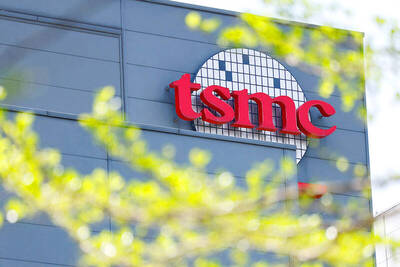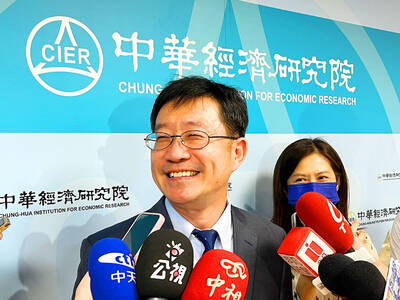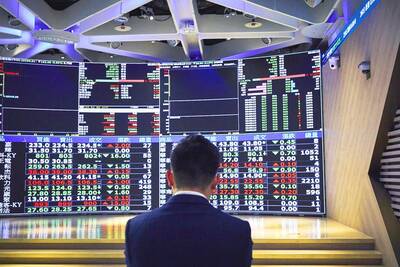New loans in China are expected to rise by more than 57 percent this year, state media said yesterday, as banks heed government calls for more credit to boost growth.
Chinese banks are forecast to extend at least 8 trillion yuan (US$1.2 trillion) in new loans this year, said Cai Esheng (蔡鶚生), vice chairman of the China Banking Regulatory Commission, according to the China Securities Journal.
That will represent a rise of 57.2 percent from the 5.09 trillion yuan in loans given out last year, according to official figures.
Chinese banks already lent 4.58 trillion yuan in the first quarter of this year to match government efforts to lift growth by priming the economic pump.
Cai said that there were “uncertainties” regarding the banks’ ability to fend off risk as they were now lending more aggressively than before, the report said.
The data so far gave little reason for alarm. The nonperforming loan ratio at commercial banks stood at 2.04 percent at the end of last month, down from 2.4 percent at the beginning of the year, official statistics showed.
However, analysts said the negative effects of the current lending spree would surface only after one or two years.
The bad loan figure would likely remain low in the first half of this year because it reflects older loans, they said.
Bad loans have been one of the main stumbling blocks for the government’s efforts to create a globally competitive banking sector.
The authorities were forced earlier this decade to inject huge sums of money into the top lenders to allow them to write off bad loans and get in shape for overseas listings.

Six Taiwanese companies, including contract chipmaker Taiwan Semiconductor Manufacturing Co. (TSMC), made the 2025 Fortune Global 500 list of the world’s largest firms by revenue. In a report published by New York-based Fortune magazine on Tuesday, Hon Hai Precision Industry Co. (better known as Foxconn) ranked highest among Taiwanese firms, placing 28th with revenue of US$213.69 billion. Up 60 spots from last year, TSMC rose 60 places to reach No. 126 with US$90.16 billion in revenue, followed by Quanta Computer Inc. at 348th, Pegatron Corp. at 461st, CPC Corp., Taiwan at 494th and Wistron Corp. at 496th. According to Fortune, the world’s

NEW PRODUCTS: MediaTek plans to roll out new products this quarter, including a flagship mobile phone chip and a GB10 chip that it is codeveloping with Nvidia Corp MediaTek Inc (聯發科) yesterday projected that revenue this quarter would dip by 7 to 13 percent to between NT$130.1 billion and NT$140 billion (US$4.38 billion and US$4.71 billion), compared with NT$150.37 billion last quarter, which it attributed to subdued front-loading demand and unfavorable foreign exchange rates. The Hsinchu-based chip designer said that the forecast factored in the negative effects of an estimated 6 percent appreciation of the New Taiwan dollar against the greenback. “As some demand has been pulled into the first half of the year and resulted in a different quarterly pattern, we expect the third quarter revenue to decline sequentially,”

WEAKER ACTIVITY: The sharpest deterioration was seen in the electronics and optical components sector, with the production index falling 13.2 points to 44.5 Taiwan’s manufacturing sector last month contracted for a second consecutive month, with the purchasing managers’ index (PMI) slipping to 48, reflecting ongoing caution over trade uncertainties, the Chung-Hua Institution for Economic Research (CIER, 中華經濟研究院) said yesterday. The decline reflects growing caution among companies amid uncertainty surrounding US tariffs, semiconductor duties and automotive import levies, and it is also likely linked to fading front-loading activity, CIER president Lien Hsien-ming (連賢明) said. “Some clients have started shifting orders to Southeast Asian countries where tariff regimes are already clear,” Lien told a news conference. Firms across the supply chain are also lowering stock levels to mitigate

DIVERSIFYING: Taiwanese investors are reassessing their preference for US dollar assets and moving toward Europe amid a global shift away from the greenback Taiwanese investors are reassessing their long-held preference for US-dollar assets, shifting their bets to Europe in the latest move by global investors away from the greenback. Taiwanese funds holding European assets have seen an influx of investments recently, pushing their combined value to NT$13.7 billion (US$461 million) as of the end of last month, the highest since 2019, according to data compiled by Bloomberg. Over the first half of this year, Taiwanese investors have also poured NT$14.1 billion into Europe-focused funds based overseas, bringing total assets up to NT$134.8 billion, according to data from the Securities Investment Trust and Consulting Association (SITCA),